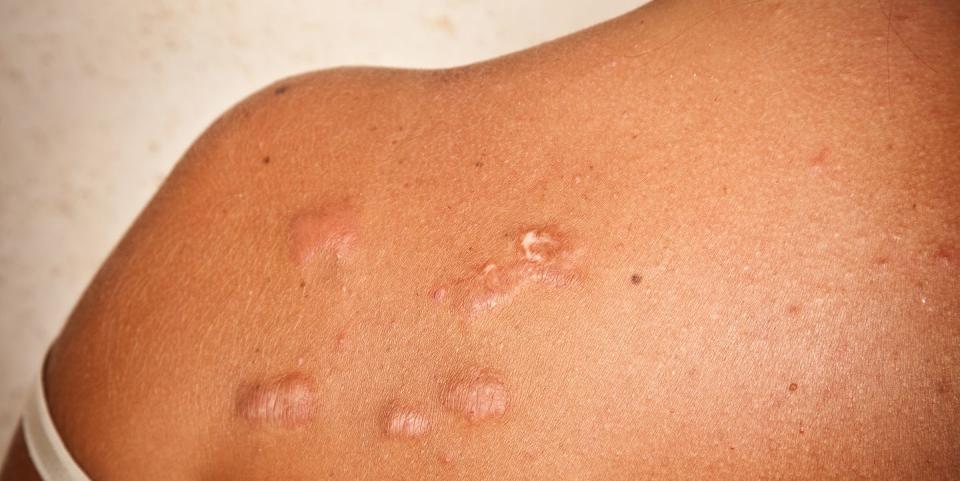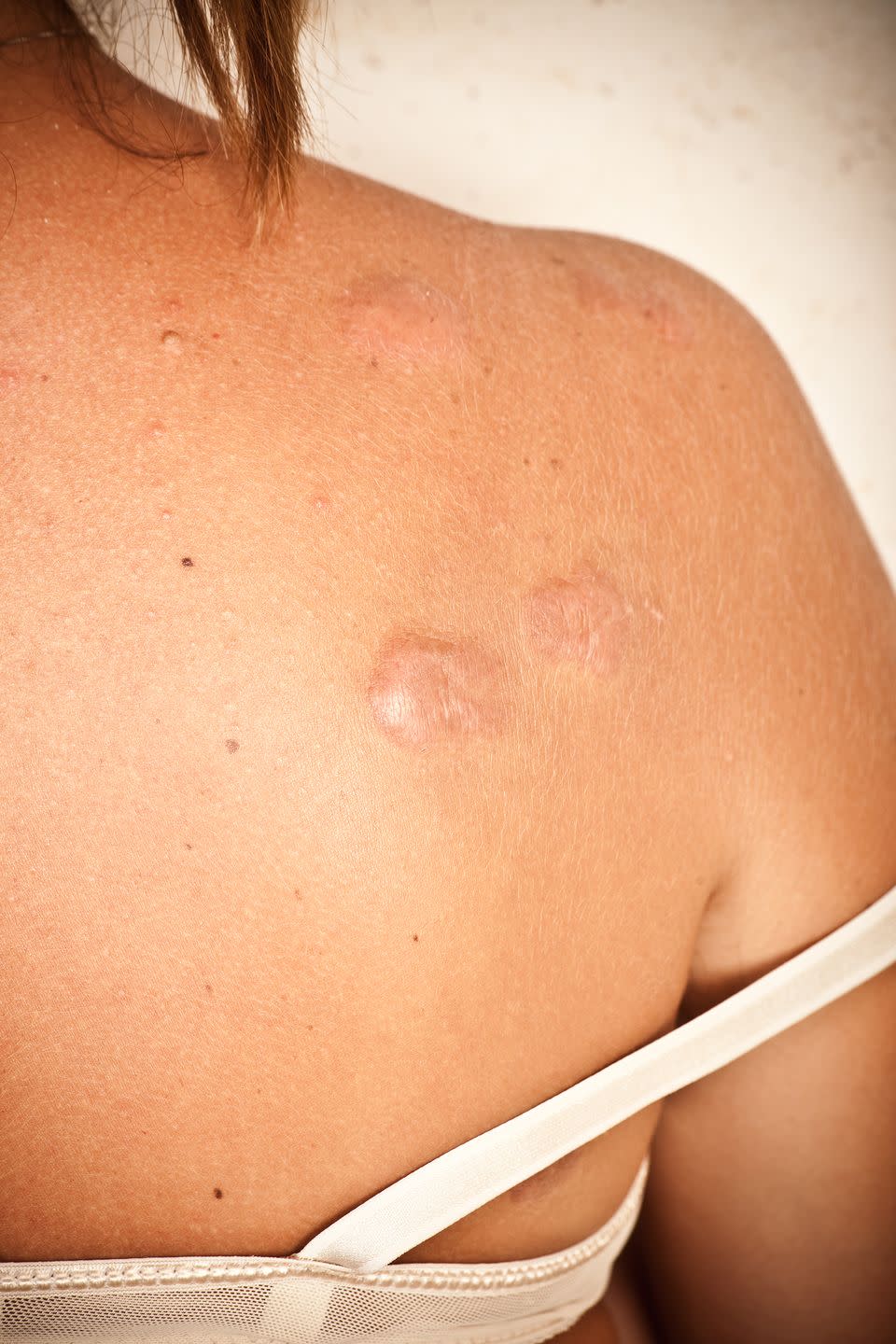What Are Keloid Scars? Everything You Need To Know About Treating Them

Getting a new piercing is all fun and games until some time has passed and you end up with a abnormal looking bump appear around the area. This raised bit of skin that often occurs is called a keloid scar.
Although mainly a superficial affliction, keloid scars can also cause the skin around the area to become itchy, painful and very sensitive if you accidentally end up knocking it. Not ideal.
But, keloid scars don't just occur after a piercing, in fact, there are a number of reasons they might appear. We've asked the experts and rounded up everything you need to know about what causes keloid scars and the available treatments that may help to manage them.
Everything You Need To Know About Keloid Scars
What are keloid scars?
In recent years there's been a positive movement on social media raising awareness of the negative stigmas around keloid scars but, by no means is it a new condition.
'Keloids are an ancient affliction, with literature dating back to 3000BC,' explains Aesthetician, Dija Ayodele. 'They are raised and bulky scars. They tend to occur within a few months of the injury.'
It's key not to confuse keloid scars with hypertrophic scars, which may look the same but don't expand. Comparatively, keloid scars stay the same size or grow, instead of regressing or shrinking.
'They're characterised by a build-up of excessive scar tissue that extends beyond the boundaries of the initial skin injury,' explains Consultant Dermatologist, Dr Alia Ahmed.
Why do keloid scars occur?
Keloids normally occur after the skin has been injured, such as after a cut, tattoo, piercing or graze.
'Keloids are caused by the over development of collagen in the second layer of the skin (dermis). When the skin is affected by an injury part of the healing process of the skin is to produce collagen. Healthy skin will stop producing collagen when the wound is healed,' says Ayodele.
Unlike with regular wounds where the collagen stops developing after the wound has healed, keloid scars occur when there is a defect in the skin that tells our body that the wound is still inflamed and still needs rebuilding, hence the raised scarring.
There are also a few other factors to why people are more prone to developing them than others. 'People with skin of colour are most at risk from developing keloid scars, especially Black people who are 15 times more likely than lighter skin counterparts,' explains Ayodele.
'White people can get keloids but it is much less prevalent. Keloids can occur at any age and to any sex, but there is some evidence to show it occurs more during puberty and pregnancy, which means that hormones may be involved to some degree. They can sometimes have a genetic component and run in families.'
Why do you get keloid scars from piercings?
There's no denying a new piercing is a shock to our system, especially for our skin. The puncture causes trauma, which then ignites the skin's inflammatory response. It doesn't help that the area around the ear is also more prone to developing keloid scarring.
'Ears are a common area where these types of scar present and typically secondary to a piercing,' says Dr Ahmed. 'Commonly affected locations include deltoid (shoulders), pre-sternal chest (upper chest), upper back, and ear.'

Can you reduce your risk of getting keloid scars?
If you know in advance you're going to undergo something that might cause a keloid scar (such as a tattoo or surgery) there are a few things you can do to minimise the damage.
Dr Ahmed advises 'Wound cleaning, protection and creating a moist wound healing environment reduces the chances of scar formation. Treatment of scars depends largely on the type of scar. Healing gels that contain a hydrocolloid can be useful at healing wounds quickly and thus reducing scar formation. They create a moist environment that encourages blood vessel formation and clot breakdown, which are helpful.'
However, for the majority of people who get keloid scars, there's normally a lack of environmental changes you can do to stop them from forming.
Ayodele believes 'If an individual is prone to keloids then it cannot be prevented. However, because keloids are prone to happen during puberty, cultural practices such as ear piercing are encouraged earlier in life.'
How to get rid of keloids
For some, scarring can have a huge negative effect on body image and self-confidence. If you're wondering how to get rid of keloids because you're experiencing negative psychological impacts from them, there are a few medical solutions to consider.
According to Dr Ahmed there are a number of different treatments:
Steroid injection directly into the scar. The treatment will not make the scar disappear but can make it smaller.
Liquid nitrogen therapy can be used to destroy scar tissue.
Surgical removal of scars is possible, but best when it is paired with another treatment to reduce the chance of recurrence (e.g. radiation, steroid or PRP injection, silicone gel).
Radiotherapy can be used after surgical excision, but should be used with caution.
Laser treatment can flatten keloid scars, however the right type of laser needs to be used.
Although the success of the treatments cannot be guaranteed and there are a number of side effects to look out for, it's worth consulting a professional to go through what might be the best option for you.
However, not everyone wants to figure out how get rid of keloid scars. It's not just the wave of positivity on social media, the beauty of keloid scars are celebrated in a number of cultures.
'There are some communities and societies in places like Sudan, Ethiopia, Papua New Guinea, Australian Aborigines (to name a few) that consider keloids beautiful and serve as outward signs of status and social standing,' explains Ayodele.
Like this article? Sign up to our newsletter to get more articles like this delivered straight to your inbox.
In need of more inspiration, thoughtful journalism and at-home beauty tips? Subscribe to ELLE's print magazine now and pay just £6 for 6 issues. SUBSCRIBE HERE
You Might Also Like

 Yahoo Finance
Yahoo Finance 